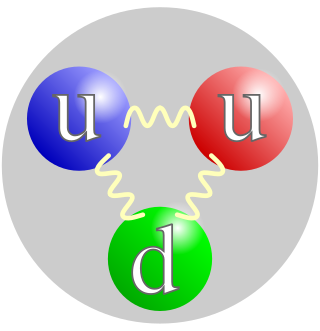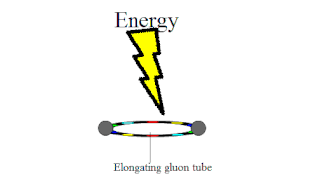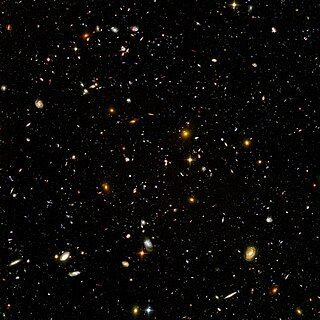In physics, the fundamental interactions or fundamental forces are the interactions that do not appear to be reducible to more basic interactions. There are four fundamental interactions known to exist:

In particle physics, an elementary particle or fundamental particle is a subatomic particle that is not composed of other particles. Particles currently thought to be elementary include electrons, the fundamental fermions, as well as the fundamental bosons, which generally are force particles that mediate interactions among fermions. A particle containing two or more elementary particles is a composite particle.

Particle physics or high energy physics is the study of fundamental particles and forces that constitute matter and radiation. The fundamental particles in the universe are classified in the Standard Model as fermions and bosons. There are three generations of fermions, although ordinary matter is made only from the first fermion generation. The first generation consists of up and down quarks which form protons and neutrons, and electrons and electron neutrinos. The three fundamental interactions known to be mediated by bosons are electromagnetism, the weak interaction, and the strong interaction.

A quark is a type of elementary particle and a fundamental constituent of matter. Quarks combine to form composite particles called hadrons, the most stable of which are protons and neutrons, the components of atomic nuclei. All commonly observable matter is composed of up quarks, down quarks and electrons. Owing to a phenomenon known as color confinement, quarks are never found in isolation; they can be found only within hadrons, which include baryons and mesons, or in quark–gluon plasmas. For this reason, much of what is known about quarks has been drawn from observations of hadrons.

In nuclear physics and particle physics, the strong interaction, which is also often called the strong force or strong nuclear force, is a fundamental interaction that confines quarks into proton, neutron, and other hadron particles. The strong interaction also binds neutrons and protons to create atomic nuclei, where it is called the nuclear force.

The universe is all of space and time and their contents, including planets, stars, galaxies, and all other forms of matter and energy. The Big Bang theory is the prevailing cosmological description of the development of the universe. According to this theory, space and time emerged together 13.787±0.020 billion years ago, and the universe has been expanding ever since the Big Bang. While the spatial size of the entire universe is unknown, it is possible to measure the size of the observable universe, which is approximately 93 billion light-years in diameter at the present day.

In nuclear physics and particle physics, the weak interaction, which is also often called the weak force or weak nuclear force, is one of the four known fundamental interactions, with the others being electromagnetism, the strong interaction, and gravitation. It is the mechanism of interaction between subatomic particles that is responsible for the radioactive decay of atoms: The weak interaction participates in nuclear fission and nuclear fusion. The theory describing its behaviour and effects is sometimes called quantum flavourdynamics (QFD); however, the term QFD is rarely used, because the weak force is better understood by electroweak theory (EWT).

The Standard Model of particle physics is the theory describing three of the four known fundamental forces in the universe and classifying all known elementary particles. It was developed in stages throughout the latter half of the 20th century, through the work of many scientists worldwide, with the current formulation being finalized in the mid-1970s upon experimental confirmation of the existence of quarks. Since then, proof of the top quark (1995), the tau neutrino (2000), and the Higgs boson (2012) have added further credence to the Standard Model. In addition, the Standard Model has predicted various properties of weak neutral currents and the W and Z bosons with great accuracy.
In physical cosmology, baryogenesis is the physical process that is hypothesized to have taken place during the early universe to produce baryonic asymmetry, i.e. the imbalance of matter (baryons) and antimatter (antibaryons) in the observed universe.
In particle physics, flavour or flavor refers to the species of an elementary particle. The Standard Model counts six flavours of quarks and six flavours of leptons. They are conventionally parameterized with flavour quantum numbers that are assigned to all subatomic particles. They can also be described by some of the family symmetries proposed for the quark-lepton generations.
The J. J. Sakurai Prize for Theoretical Particle Physics, is presented by the American Physical Society at its annual April Meeting, and honors outstanding achievement in particle physics theory. The prize consists of a monetary award (US$10,000), a certificate citing the contributions recognized by the award, and a travel allowance for the recipient to attend the presentation. The award is endowed by the family and friends of particle physicist J. J. Sakurai. The prize has been awarded annually since 1985.
In cosmological models of the Big Bang, the lepton epoch was the period in the evolution of the early universe in which the leptons dominated the mass of the Universe. It started roughly 1 second after the Big Bang, after the majority of hadrons and anti-hadrons annihilated each other at the end of the hadron epoch. During the lepton epoch, the temperature of the Universe was still high enough to create neutrino and electron-positron pairs. Approximately 10 seconds after the Big Bang, the temperature of the universe had fallen to the point where electron-positron pairs were gradually annihilated. A small residue of electrons needed to charge-neutralize the Universe remained along with free streaming neutrinos: an important aspect of this epoch is the neutrino decoupling. The Big Bang nucleosynthesis epoch follows, overlapping with the photon epoch.
In physical cosmology, the hadron epoch started 20 microseconds after the Big Bang. The temperature of the universe had fallen sufficiently to allow the quarks from the preceding quark epoch to bind together into hadrons. Initially, the temperature was high enough to allow the formation of hadron/anti-hadron pairs, which kept matter and anti-matter in thermal equilibrium. Following the annihilation of matter and antimatter, a nano-asymmetry of matter remains to the present day. Most of the hadrons and anti-hadrons were eliminated in annihilation reactions, leaving a small residue of hadrons. Upon elimination of anti-hadrons, the Universe was dominated by photons, neutrinos and electron-positron pairs. One refers to this period as the lepton epoch.
In physical cosmology, the electroweak epoch was the period in the evolution of the early universe when the temperature of the universe had fallen enough that the strong force separated from the electroweak interaction, but was high enough for electromagnetism and the weak interaction to remain merged into a single electroweak interaction above the critical temperature for electroweak symmetry breaking. Some cosmologists place the electroweak epoch at the start of the inflationary epoch, approximately 10−36 seconds after the Big Bang. Others place it at approximately 10−32 seconds after the Big Bang when the potential energy of the inflaton field that had driven the inflation of the universe during the inflationary epoch was released, filling the universe with a dense, hot quark–gluon plasma. Particle interactions in this phase were energetic enough to create large numbers of exotic particles, including W and Z bosons and Higgs bosons. As the universe expanded and cooled, interactions became less energetic and when the universe was about 10−12 seconds old, W and Z bosons ceased to be created at observable rates. The remaining W and Z bosons decayed quickly, and the weak interaction became a short-range force in the following quark epoch.
In physical cosmology, assuming that nature is described by a Grand Unified Theory, the grand unification epoch was the period in the evolution of the early universe following the Planck epoch, starting at about 10−43 seconds after the Big Bang, in which the temperature of the universe was comparable to the characteristic temperatures of grand unified theories. If the grand unification energy is taken to be 1015 GeV, this corresponds to temperatures higher than 1027 K. During this period, three of the four fundamental interactions—electromagnetism, the strong interaction, and the weak interaction—were unified as the electronuclear force. Gravity had separated from the electronuclear force at the end of the Planck era. During the grand unification epoch, physical characteristics such as mass, charge, flavour and colour charge were meaningless.
In physical cosmology, the photon epoch was the period in the evolution of the early universe in which photons dominated the energy of the universe. The photon epoch started after most leptons and anti-leptons were annihilated at the end of the lepton epoch, about 10 seconds after the Big Bang. Atomic nuclei were created in the process of nucleosynthesis, which occurred during the first few minutes of the photon epoch. For the remainder of the photon epoch, the universe contained a hot dense plasma of nuclei, electrons and photons.
A weakless universe is a hypothetical universe that contains no weak interactions, but is otherwise very similar to our own universe.
The chronology of the universe describes the history and future of the universe according to Big Bang cosmology.

In classical physics and general chemistry, matter is any substance that has mass and takes up space by having volume. All everyday objects that can be touched are ultimately composed of atoms, which are made up of interacting subatomic particles, and in everyday as well as scientific usage, "matter" generally includes atoms and anything made up of them, and any particles that act as if they have both rest mass and volume. However it does not include massless particles such as photons, or other energy phenomena or waves such as light or heat. Matter exists in various states. These include classical everyday phases such as solid, liquid, and gas – for example water exists as ice, liquid water, and gaseous steam – but other states are possible, including plasma, Bose–Einstein condensates, fermionic condensates, and quark–gluon plasma.

The idea that matter consists of smaller particles and that there exists a limited number of sorts of primary, smallest particles in nature has existed in natural philosophy at least since the 6th century BC. Such ideas gained physical credibility beginning in the 19th century, but the concept of "elementary particle" underwent some changes in its meaning: notably, modern physics no longer deems elementary particles indestructible. Even elementary particles can decay or collide destructively; they can cease to exist and create (other) particles in result.






